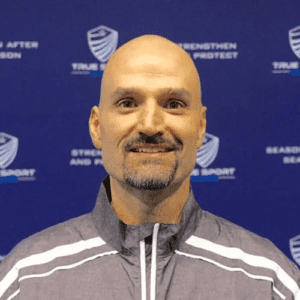Indulge me for this blog post. This will be an anecdotal recount of feedback from patient experiences with one being very recent. This episode triggered the idea and from the outcome, it certainly warrants reporting.
My newsletters typically go out on the last Monday of the month at 7 a.m. Little did I know the impact my newsletter would have back in August.
Mrs. “Smith’s” son rolled his ankle playing volleyball in high school over a weekend. Mrs. Smith took her son to urgent care where they took x-rays and advised him to see his pediatrician first thing Monday morning. At this moment, Mrs. Smith had a decision to make about the next step to treat her son’s sports injury.
The Typical Sports Injury Rehabilitation Path
Mrs. Smith knows how the system works and is fully aware that even if they got in to see the pediatrician on Monday, they would likely refer the injured athlete to an orthopedist after first shutting them down from their sport. With no “connections”, it would likely be a couple of weeks before they could get in to see an ortho.
A wise ortho once told me that they can only do 1 of 4 things:
- Refer to PT,
- Prescribe meds,
- Inject meds, or
- Perform surgery.
I would bet they would have at least started with a PT prescription of 2-3 times per week for 6-8 weeks.
After this initial round of PT, a follow-up would have to be performed by the ortho so that the patient could be cleared to compete.
For a high school senior who is playing in their last year, this could have meant the entire season was lost due to logistics and therapy duration.
True Sport Care Injury Rehabilitation Path without Shut-Down
Monday morning Mrs. Smith (who has been a patient in the past) was looking for a sign from above that could guide her with her son’s injury. My newsletter was the sign she was looking for. The topic of the newsletter was off-season athlete preparation and the importance of athlete evaluation. The timing couldn’t have been better.
1. Same-Day Appointment
Mrs. Smith called our Smithtown sports medicine office first thing Monday morning and was able to get her son in ASAP due to a cancellation.


2. Review X-Rays
We knew that his urgent care x-ray was negative so we assessed his ligamentous stability, range of motion, and strength. We didn’t feel this was severe enough to warrant any shutdown.
3. Instrument-Assisted Soft Tissue Treatment
We know that the normal ligament injured with an ankle roll needed help in stitching itself back together. Our instrument-assisted soft tissue treatment does this with great success. The first month is when the scar tissue is remodeling the injured area. Soft tissue treatment helps to direct the stitching cells (fibroblasts) to create a more robust and better-organized scar. Scar tissue is technically normal tissue in a disorganized pattern. This is great for stability and protection but it’s terrible for movement and fascial gliding.


4. Test for Muscular Weaknesses and Prescribe a Home Rehabilitative Exercises
We performed thorough muscle testing and evaluation and noted multiple weaknesses that could very well have predated and possibly even caused the injury! The athlete’s rehabilitation therapy plan included at-home exercises to not only strengthen the injured leg but to prevent a future recurrence. Due to our investigative nature and “leave no stone unturned” attitude we found weaknesses near to but also far from the injury site.
This is also something that many practitioners fail to effectively do. This next statement is the most important fact when it comes to sports injuries so it warrants an all-caps alert. THE LEAST EFFECTIVE PRACTITIONERS ARE THE ONES WHO ONLY TREAT THE SITE OF PAIN. The number one injury suffered after an ankle sprain is…another ankle sprain. The likely cause is improper rehabilitation or no rehabilitation at all.


5. Taping For Practices and Games
Due to the nature and freshness of the athlete’s injury, he was advised to tape his ankle before practices and games. He was also instructed to continue his therapeutic exercises for a few weeks and continue to get the injured area treated so that the healing could be expedited. He never missed a game or practice and to date has not re-injured his ankle.
Fast-Track Recovery for Musculoskeletal Injuries
Consider our office a way to fast-track any musculoskeletal injury. If you think of the two paths spoken about in this article you should observe a few facts.
- The main one is convenience. Same-day initial visit, analysis, and treatment. Because of our advanced techniques, treatment duration is usually much shorter than the typical 6-8 weeks. A one-stop shop with unrivaled efficiency.
- The second one is cost. We know we are more expensive than many other facilities but due to the effectiveness of our system, patients need fewer visits and are discharged sooner. Add up your copays from 2-3 MD visits, and 24 PT visits. I’m sure it’s a hefty number. Even if you’re paying cash and have no insurance, our 1X/week visit costs over a month would still be far less.
Please be aware that we all have a very keen sense of awareness of when an injury may be beyond our abilities or doesn’t respond quickly. We have a great circle of MD’s that we not only feel very comfortable referring to but can also typically facilitate an appointment with them fairly quickly. Having one Doc handle most of the care seems to make the most sense rather than being on the typical medical merry-go-round.
To sum up, Mrs. Smith was overjoyed because her son had no downtime and didn’t miss any of his senior season. Please consider our sports medicine clinic for any of your musculoskeletal injuries or complaints in the future. Our patients would certainly second the notion.


